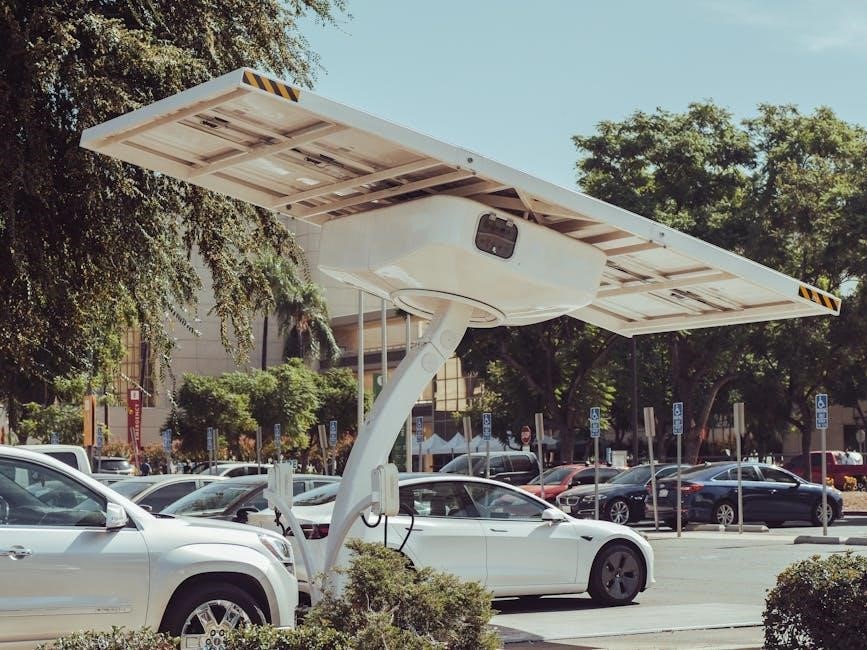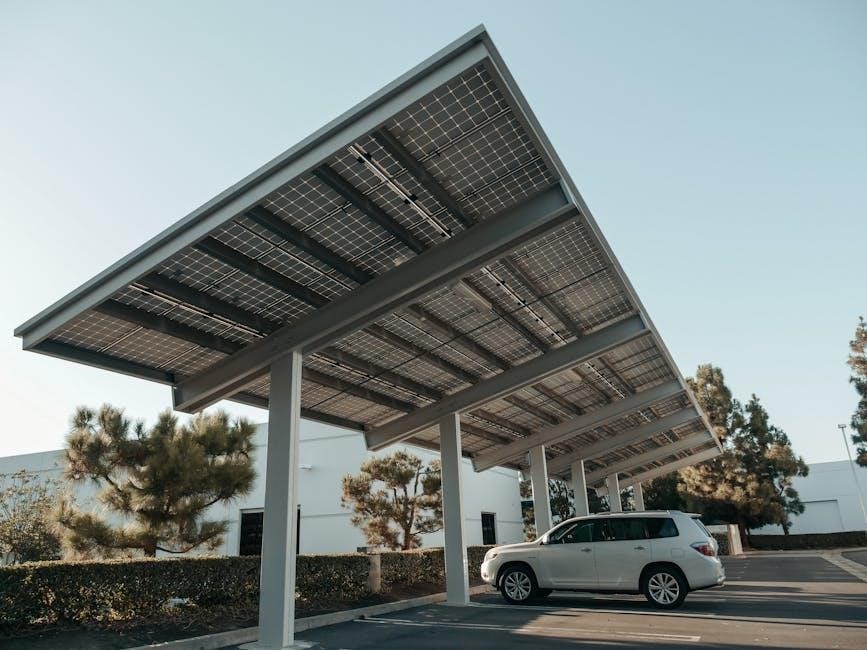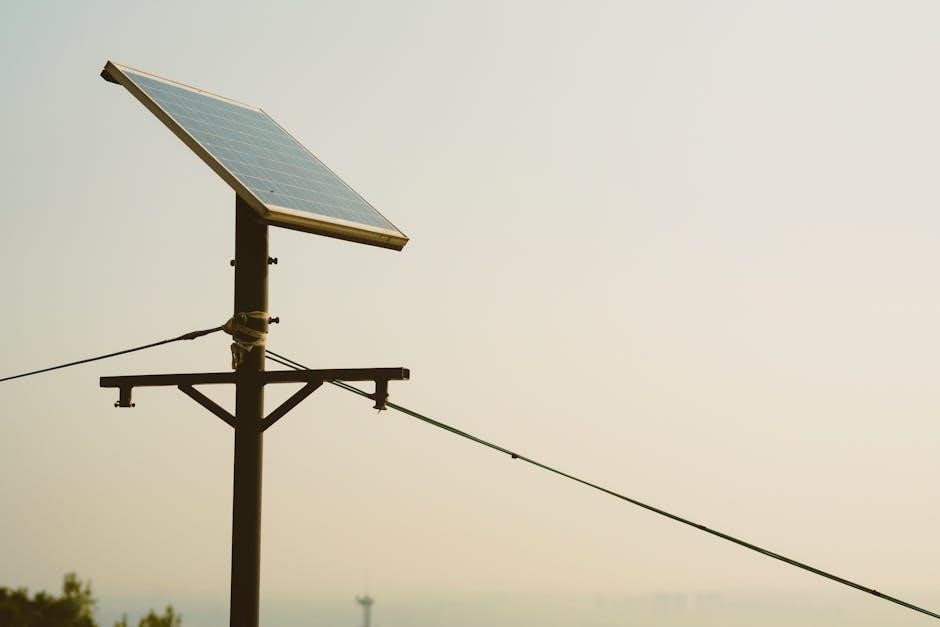Solar Panel Wiring Diagram PDF: A Comprehensive Guide
Embark on a journey to understand solar panel wiring with our comprehensive guide. This resource offers insights into creating efficient and safe solar energy systems; Explore wiring diagrams, safety measures, and troubleshooting tips. Maximize your solar panel system’s potential today!
Solar panel wiring diagrams are essential for anyone looking to install or maintain a solar power system, whether it’s for residential, RV, or portable use. These diagrams provide a visual representation of how the various components of a solar system are connected, ensuring safe and efficient operation. Understanding these diagrams is crucial for proper installation, troubleshooting, and overall system performance.
A solar panel wiring diagram typically illustrates the connections between solar panels, charge controllers, inverters, batteries, and other essential components. By following a detailed diagram, you can ensure that your solar panels are wired correctly, maximizing energy production and minimizing the risk of electrical hazards. This guide aims to provide you with a comprehensive understanding of solar panel wiring diagrams and their importance in solar power systems.
Understanding Basic Solar Panel Wiring Concepts
Grasping the fundamentals of solar panel wiring is crucial for effective solar energy implementation. Series, parallel, and series-parallel configurations each offer unique benefits and considerations for system design and performance optimization.
Series Wiring
Series wiring involves connecting solar panels in a chain, linking the positive terminal of one panel to the negative terminal of the next. This configuration increases the voltage while maintaining the same current. Think of it like connecting batteries end-to-end in a flashlight to increase the overall voltage. It is essential to watch the voltage limits. During daylight, there can be high DC voltage in the circuit.
Series connections are suitable for systems that require higher voltage to match the input requirements of inverters or charge controllers. However, if one panel in the series is shaded or malfunctions, the performance of the entire string can be significantly reduced, and the connection is made via an isolator.
Parallel Wiring
Parallel wiring connects solar panels side-by-side, linking all positive terminals together and all negative terminals together. This configuration increases the current while maintaining the same voltage. Unlike series wiring, parallel wiring is less susceptible to performance degradation due to shading on a single panel.
If one panel is shaded, the others continue to operate at their full potential, and the panel continues to operate at its full potential as well. Parallel connections are useful when you need to increase the current to meet the demands of your system, such as charging batteries more quickly.
Ensure proper fusing is used to protect the wiring and equipment from overcurrent situations.
Series-Parallel Wiring
Series-parallel wiring combines the features of both series and parallel configurations. It involves connecting multiple strings of solar panels in series and then connecting those strings in parallel. This approach allows you to increase both the voltage and current of your solar array.
This is particularly useful when your inverter or charge controller requires a specific voltage range, and you also need to meet a certain current requirement. Series-parallel wiring can also enhance system resilience to shading, as only one string of panels is affected.
Careful planning and calculations are essential to ensure that the voltage and current levels are within the acceptable range of your equipment.

Essential Components in a Solar Panel System
A solar panel system comprises several key components. These include solar panels, charge controllers, inverters, and batteries. Each component plays a vital role in harnessing solar energy and converting it into usable electricity for various applications.
Solar Panels
Solar panels are the fundamental building blocks of any solar power system. These panels capture sunlight and convert it into direct current (DC) electricity through the photovoltaic effect. Solar panels can be wired in series or parallel configurations to achieve the desired voltage and current levels for the system. Understanding the specifications of your solar panels, such as voltage (VOC) and current, is crucial for proper wiring.
Different types of solar panels exist, including monocrystalline and polycrystalline, each with varying efficiency and performance characteristics. The choice of solar panel depends on factors like available space, budget, and energy needs. Proper installation and maintenance are essential for maximizing solar panel lifespan and performance.
Charge Controller
A charge controller, also known as a charge regulator, is a crucial component in a solar panel system, especially when using batteries. Its primary function is to regulate the voltage and current coming from the solar panels to prevent overcharging and damage to the batteries. Charge controllers also protect the batteries from deep discharging, extending their lifespan.
There are two main types of charge controllers: Pulse Width Modulation (PWM) and Maximum Power Point Tracking (MPPT). MPPT charge controllers are more efficient as they optimize the power output from the solar panels. Selecting the right charge controller depends on the system voltage, solar panel array, and battery type.
Inverter
An inverter is an essential component in a solar panel system, responsible for converting the direct current (DC) electricity generated by solar panels into alternating current (AC) electricity, which is the standard form of electricity used in most homes and businesses. Inverters come in various types, including string inverters, microinverters, and hybrid inverters.
String inverters are commonly used in residential solar systems, while microinverters are attached to individual solar panels to maximize energy production. Hybrid inverters integrate battery storage capabilities, allowing for energy storage and backup power. Selecting the right inverter depends on the specific requirements of the solar panel system and the type of loads it will power.
Batteries
Batteries are a crucial component in off-grid and grid-tied solar systems with battery backup. They store the excess electricity generated by solar panels, allowing you to use it when the sun isn’t shining or during power outages. There are various types of batteries used in solar systems, including lead-acid, lithium-ion, and nickel-iron batteries.
Lithium-ion batteries are becoming increasingly popular due to their high energy density, long lifespan, and low maintenance requirements. The battery bank’s capacity should be carefully calculated based on your energy consumption and desired autonomy. Proper battery maintenance, including regular inspections and charging, is essential for ensuring optimal performance and longevity.

Wiring Diagrams for Different Solar Setups
Explore various solar setups with detailed wiring diagrams tailored for residential, RV, and portable systems. Understand the specific wiring requirements and configurations for each application. Optimize your solar power installation efficiently and safely.
Residential Solar Systems
Residential solar systems harness sunlight to power homes, reducing reliance on traditional energy sources. Wiring diagrams are crucial for safe and efficient installation. These diagrams illustrate how solar panels connect in series or parallel to achieve the desired voltage and current. Typically, panels are wired to a DC isolator, then to an inverter, converting DC to AC for household use. Proper grounding is essential for safety.
Wiring configurations vary depending on the system size and energy needs. Understanding these diagrams ensures optimal performance and minimizes potential hazards. Always consult with qualified professionals for installation and maintenance to comply with local regulations and ensure system longevity.
RV Solar Systems
RV solar systems provide off-grid power for mobile living. Wiring diagrams are essential for safe and effective installation within the confined space of a recreational vehicle. These diagrams show how solar panels connect to charge controllers, batteries, and inverters. Common configurations use Anderson plugs for easy connection and disconnection of portable solar panels.
Circuit breakers and fuses protect the system from overloads. Wiring must be properly sized to handle the current. Diagrams also specify grounding to the RV chassis for safety. Understanding these diagrams allows RVers to enjoy sustainable power while traveling, ensuring reliable electricity for appliances and electronic devices. Always follow safety guidelines during installation.
Portable Solar Systems
Portable solar systems offer flexible power solutions for camping, emergencies, and remote locations. Wiring diagrams for these systems highlight simplicity and ease of use. A typical portable system includes a solar panel, charge controller, battery, and inverter, all connected via clearly illustrated diagrams. Anderson plugs often feature for quick panel connections.
Diagrams emphasize correct polarity and fuse placement for safety. These systems are designed for easy setup and portability. Diagrams also show how to connect loads like lights and phone chargers. Understanding the wiring ensures efficient energy capture and storage. They allow users to harness solar power wherever they go, providing reliable off-grid electricity.

Safety Precautions for Solar Panel Wiring
Prioritize safety when wiring solar panels. High DC voltage is a risk. Use DC isolators during wiring. Ensure proper grounding. Understand voltage limits. Always follow safety guidelines to prevent accidents and ensure system longevity.
Using DC Isolators
DC isolators play a critical role in solar panel systems, particularly during installation and maintenance. They act as safety switches, disconnecting the DC voltage from the solar panels to the inverter. This is essential because during daylight hours, solar panels generate high DC voltage, posing a risk of electric shock. By keeping the DC isolator open during wiring, you ensure a safe environment for connecting the panels.
DC isolators are crucial for maintenance as well, allowing technicians to safely work on the inverter or other system components without the risk of electrical hazards. Installation of DC isolators should always follow manufacturer’s instructions.
Proper Grounding
Proper grounding is paramount in any solar panel system to ensure safety and protect against electrical faults. Grounding provides a path for stray electrical currents to safely dissipate, preventing electric shock and minimizing the risk of fire. A well-grounded system also protects sensitive electronic components, like the inverter and charge controller, from voltage surges caused by lightning or other electrical disturbances.
Follow local electrical codes and manufacturer guidelines for grounding procedures, as they may vary depending on the system size and location. Ensure all components, including the solar panels, racking system, and inverter, are properly grounded to a common grounding point.
Understanding Voltage Limits
Understanding voltage limits is crucial when wiring solar panels to prevent damage to equipment and ensure safe operation. Each component in a solar system, including solar panels, charge controllers, and inverters, has specific voltage limits that must not be exceeded. Exceeding these limits can lead to component failure, reduced system performance, and potential safety hazards.
Solar panels are often wired in series to increase voltage, so it’s essential to calculate the total voltage of the series string. Ensure that the combined voltage of the panels does not exceed the maximum input voltage of the charge controller or inverter. Refer to component datasheets for voltage specifications and follow manufacturer recommendations.

Troubleshooting Common Wiring Issues
When experiencing issues with your solar panel system, troubleshooting wiring problems is often the first step. Common wiring issues include loose connections, corroded terminals, and incorrect wiring configurations. Start by visually inspecting all wiring connections for any signs of damage or loose connections. Use a multimeter to check voltage and continuity at various points in the system to identify any breaks in the circuit.
Incorrect polarity, where positive and negative wires are reversed, can also cause problems. Ensure that all wiring connections match the solar panel wiring diagram and component specifications. If you’re unsure about any aspect of the wiring, consult with a qualified solar installer or electrician.
